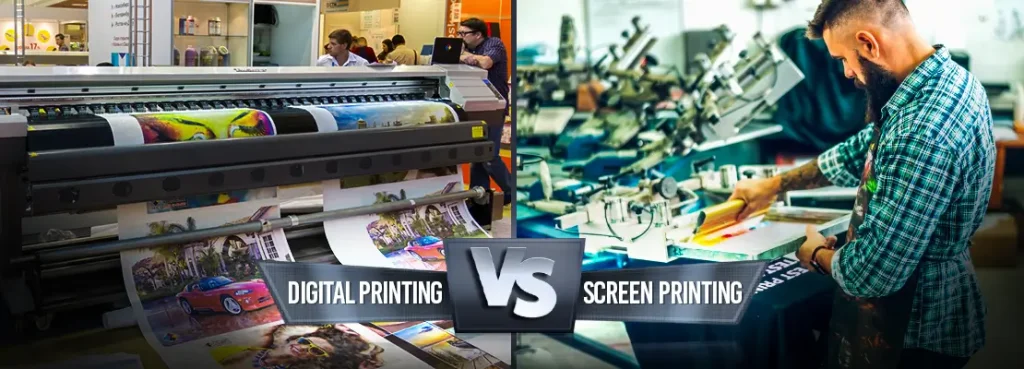In the rapidly evolving world of printing, new technologies have revolutionized the industry, offering a range of innovative methods. While digital printing has gained popularity among printing companies, some individuals still hold a preference for the classic technique of screen printing.
As the debate between digital printing and screen printing continues, it becomes essential to grasp the fundamental distinctions between the two.
Take your print materials to the next level with our custom printing solutions. Whether it’s booklets, catalogs, comic books, or flyers, we’ve got you covered. Contact us now to discuss your printing needs!
This blog post aims to provide you with a comprehensive comparison of digital printing vs.screen printing, empowering you to make informed decisions when choosing the ideal printing method for your specific project requirements.
Let’s delve into the key differences between these two approaches
Difference in terms of Printing Technology
Digital printing and screen printing are two different methods used in the age of print production.
Digital printing is a modern method that utilizes digital technology to directly transfer an image onto paper or other material via a computer-controlled printer. The process is much faster than traditional screen printing as it does not require the setup time associated with screens.
On the other hand, screen printing is an older production method that relies on screens and inks to transfer an image onto paper or other material.
Print Quality Difference
The print quality difference here is quite apparent. However, both these printing types offer quality prints. But again, digital printing takes the lead. It offers better-quality prints.
Screen printing also offers decent-quality prints. However, it could be better for printing fine details or texts. So, keep this difference in mind.
Cost Difference
The cost of the overall price is the primary difference between these two types of printing methods. Digital printing is more cost-effective for small orders and shorter runs because it eliminates the need for setup fees associated with screen printing.
So, it is more cost-effective than digital printing due to the ability to print one color at a time and reduce production costs.
Screen printing requires more energy and labor to set up the initial screens, making it more expensive for short-run jobs.
However, screening can be more expensive when it comes to larger runs. The price difference is based on the overall cost. Digital printing is more cost-effective for small orders and shorter runs because of the fees associated with screen printing.
More cost-effective than digital printing due to the ability to print one color at a time and reduce production costs.
Ready to make a lasting impression? Explore our wide range of custom printing services to create personalized business cards, stationery, and more. Start designing today!
What is Digital Printing?
Digital printing is a type of printing technology that uses digital or electronic files from a computer to produce high-quality prints. Digital printing eliminates the need for traditional plates and chemical processing used in other printing types.
This type of printing is ideal for producing high-resolution images, such as photographs and full-color graphics. It can also be used to print variable data like names or addresses on documents, which makes it great for personalized items like business cards or direct mail pieces.
Compared to other types of printing, digital printing requires less setup time and has a lower cost per piece, making it an efficient option for any project size.
Advantages of Screen Printing
High-Quality Output
Unlike screen printing, digital printing offers excellent print quality, often comparable to traditional offset printing. It can precisely reproduce intricate details, gradients, and color accuracy, making it suitable for various applications.
Quick Turnaround Time
Since digital prints don’t involve time-consuming setup processes, it offers a quick turnaround time. Files can be sent directly to the printer, and the printing process can start immediately, allowing for faster production and delivery.
Customization Option
Digital printing enables easy customization and personalization of each print piece. Variable data printing allows unique content, such as personalized names, addresses, or images, to be incorporated into each printed item, making it suitable for direct marketing campaigns and promotional materials.
Reduced Waste
With digital printing, there is less material waste than traditional printing methods. Since there are no setup costs or minimum quantity requirements, businesses can print what they need, minimizing excess inventory and reducing waste.
Disadvantages of Screen Printing
Limited Color Range
While digital printing offers excellent print quality, it may need to consistently achieve the same wide color range as traditional printing methods. Some vibrant or specialty colors may be challenging to reproduce accurately, which can be a limitation for specific print projects.
Higher Per-Unit Cost
Digital printing becomes less cost-effective for large print runs. As the quantity increases, the price per unit may become higher than traditional offset printing methods. Therefore, offset printing is typically more economical for bulk production.
What is Screen Printing?
Screen printing is one of the most popular methods for creating custom apparel and art. Screen printing works quite differently than other printing services. It uses a stencil-based process to apply ink or other substances onto items such as t-shirts, sweatshirts, hats, canvas bags, etc.
The specialty ink is applied using mesh screens which act as a barrier on top of the desired design area. After applying the ink, it needs to be cured with heat to become permanent.
Pros of the Screen Printing Process
Durability
Screen printing offers exceptional durability. The ink used in the process is typically thicker and more substantial than in other printing methods, resulting in prints that withstand frequent washing, wear, and tear.
Vibrant Colors and Special Effects
Screen printing can produce vibrant and opaque colors, including specialty inks like metallics and fluorescents. It allows for layering multiple colors on each other, creating eye-catching designs with depth.
Versatility
Screen printing is versatile and compatible with various substrates, including textiles, paper, plastics, glass, and metal.
It can be used on a wide range of products, from t-shirts and hoodies to posters and stickers, offering flexibility in terms of applications.
Long-Lasting and Fade-Resistant
Screen printing, such as garment printing, uses inks that are typically highly pigmented and formulated to withstand fading from UV exposure. It makes screen-printed items resistant to color degradation over time.
Cons of the Screen Printing Process
Setup Time and Cost
Screen printing involves a relatively complex setup process compared to digital printing methods. Creating screens and preparing the artwork can be time-consuming and require specialized skills and equipment.
The print method and setup costs associated with screen printing, including screen creation and ink preparation, can be higher, especially for small print runs. So, while screen printing may not need a digital printer, it costs a lot.
Limited Detail and Resolution
Screen printing may not be suitable for designs with intricate details, small text, or complex gradients. The mesh used in the screen can only produce a certain level of detail, making it less suitable for designs that require high-resolution or fine lines.
Limited Color Accuracy
Achieving precise color matching in screen printing can be challenging, particularly for specific shades or specialty colors. The ink mixing process involves manual adjustments, possibly resulting in slight variations from the intended colors.
Want to promote your event or organization with style? Experience our custom printing services by Stampa Prints. Get noticed today!
Factors to Consider When Choosing Between Digital Printing and Screen Printing:
1: Project Size and Quantity: Digital printing is advantageous for small quantities, while screen printing is more cost effective for larger print runs.
2: Design Complexity: Digital printing is better suited for intricate designs with fine details, while screen printing excels in bold and solid color designs.
3: Time Constraints: Digital printing offers quick turnaround times, making it suitable for time-sensitive projects, whereas screen printing may require more time due to the setup involved.
4: Desired Color Range: If you require a wide range of colors or precise color matching, digital printing offers better color accuracy. Screen printing is known for vibrant and opaque colors, particularly on dark fabrics.
5: Durability Requirements: If durability is a priority, such as for outdoor signage or apparel that requires frequent washing, screen printing’s thick layers of ink provide excellent longevity.
Final Thoughts
In conclusion, understanding the distinctions between digital and screen printing is essential for selecting the suitable method for your unique needs. Digital printing offers efficiency and speed for short-run projects, while screen printing stands out with its vibrant colors and durability for long-run endeavors.
You can make a well-informed decision by carefully considering factors such as project size, design complexity, color requirements, and durability. Trust Stampa Prints, a reliable provider of online custom printing & packaging services in USA, to bring your vision to life. Choose the ideal printing approach and create remarkable prints!
When you’re ready to bring your vision to life,
We value your opinion! If you have any feedback or thoughts to share about our blog post on Digital Printing vs. Screen Printing: Understanding the Key Differences, we would love to hear from you.
Please feel free to leave your comments and suggestions at support@stampaprints.com. Your feedback helps us improve and provide valuable content for our readers. Thank you!

